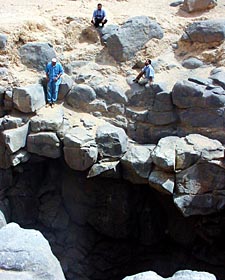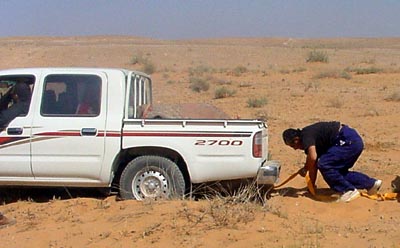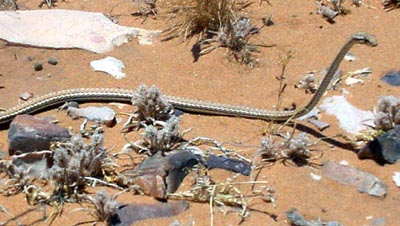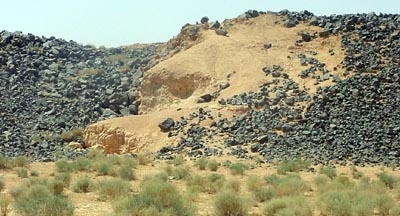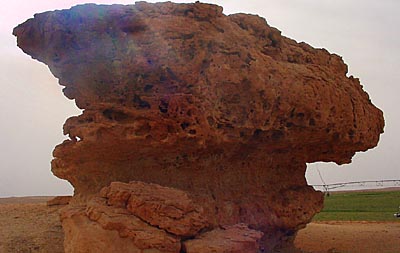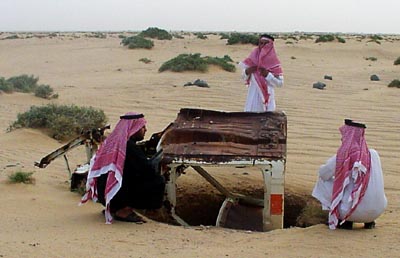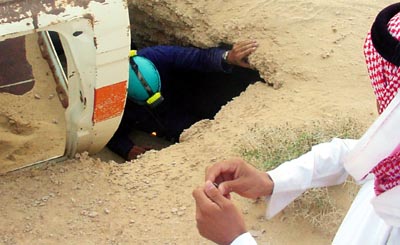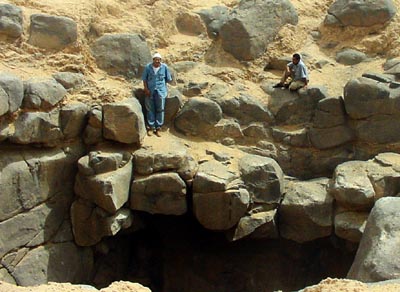








VOYAGE TO THE STAR WELL
IS THERE AN ARCHEOLOGICAL TREASURE-TROVE
25 METERS BELOW?
All Photos by Mahmoud Al-Shanti
In May, 2004, the SGS Cave Unit undertook a trip to the northern reaches of the kingdom to determine whether there are any interesting caves in a vast lava field which spills over the Saudi border into Syria and Jordan. Susy and I were in the Azores when Mahmoud Al-Shanti, Abdulrahman Al-Jouid, Saeed Al-Amoudi, along with Awad Falleh, a caving enthusiast from Al Jawf, flew up to the lonely town of Gurayat. They figured they’d make their search a lot easier if they inquired about caves at the sprawling government wildlife preserve which encompasses 170 square kms of this area, but the director declared there were none at all. “Of course you are free to look,” he said...
...They did have topo maps, compasses and GPS units, but at last they had to admit that there was no cave where they hoped to find one and back they went to the wildlife headquarters, again at 11 kph. Here the preserve’s official pilot repeated what the director had said: “There are no caves here.” So Mahmoud and company decided to try a new area.
“We’ll go to Nabk Abu Gassar City,” announced Mahmoud, “and to save time, we’ll drive straight there using the GPS...”
BORDER PATROL
Now, it took the team four hours to negotiate their way through sand traps and farms before they finally reached NAG City and got the showers they had been dreaming of. After a rest of undisclosed length, they drove off to the zone along the Saudi-Jordan border where they ran smack into the Border Patrol which informed them that hunting for caves (or anything else) is not allowed without the permission of the local Emir.
At this point we must insert into the saga a very long hiatus for finding the Emir, exchanging pleasantries, etc. etc. Final result: “There are no caves here,” said the Emir’s assistant. But he did suggest our team go north to a place called Qalib Hudder, “and on the way be sure to check out the Big Rock.”
|
...The first hole pointed out by the guides was 30 cms in diameter (one foot) and looked a lot more like a dhubb hole than a cave. This was not encouraging....
|
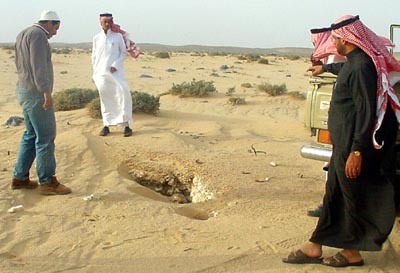 |
THE ANCIENT WELL OF QALIB AL BANAAT
Now it was nearly sunset. They would have to “drive like crazy” to reach what sounded like the only decent cave in the area, known as Mudhrub Najem.
Just as darkness fell, near a place called Qalib Al Banaat, they reached the foot of a basalt hill and climbed upward. A great black hole was waiting for them at the top. This was a real cave!
|
...Mudhrub Najem means “the place hit by a star,” but rather than an impact crater, it seems to be a natural pit occurring in a hill composed of layers of basalt, sediment and limestone....
|
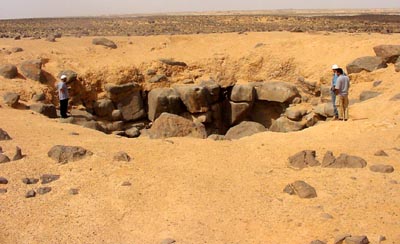 |
|
... The entrance is 13 meters wide and the floor lies 25 meters below... Detail of Mudhrub Najem Well. Click on the picture to see the full Profile-Plan sketch by Mahmoud Al-Shanti. |
 |
...Deep grooves in the basalt blocks at the lip of the pit indicate it was long used as a water well. We can get an idea of its age from the inscriptions written in Thamudic script on many of the large rocks surrounding the old well, which, in turn, is enclosed by what appear to be the ruins of an ancient city.
The Thamudic language was used in northern Arabia approximately 2000 years ago. It was written with a consonantal alphabet of 28 letters usually, but not always, from right to left, like other Semitic scripts.
 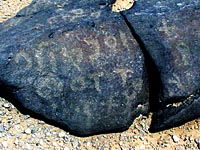
Two examples of Thamudic writing near the well. For more information, have a look at inscriptions transliterated by the Saudi Museum of Natural History. |
This evidence of the well’s great age has spurred local people to try getting down to the bottom of it, perhaps in the hopes of finding ancient coins or some other form of treasure. As is normal whenever “ten o’clock spelunkers” try to negotiate deep pits, several dead bodies now lay at the bottom of Mudhrub Najem Cave. One man decided to make himself a ladder using old tires chained together. Somewhere on the way down, one of the chains broke. Remains of this tire ladder can still be seen at the bottom of the pit. Another adventurer opted for a more modern approach. He put a 25-meter-long aluminum extension ladder down the hole and began to climb down. He, too, didn’t get very far: the ladder twisted and he fell to his death. All over the world, such accidents keep occurring even among professional rescuers in the military, civil defense and Red Cross/Crescent, simply because these people have not been trained in the very specialized field of Cave Rescue, nor could they ever be, because (and you can quote me on this) only a good caver can become a good cave rescuer.
THE END.
John Pint
Remote Caving Consultant
Saudi Geological Survey
